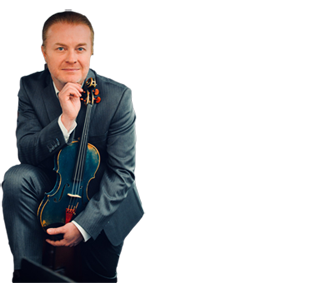The director of the festival Kocianovo Ústí Pavel Šporcl will have a tour in Japan before the opening of the 60th “Kocianka” and shortly after his 45th birthday, he says:
“I celebrate but with work!”
Ústí n. O. – In the last days and weeks, the artistic director of the festival Kocianovo Ústí and the patron of the jubilee 60th competition Pavel Šporcl follows the motto from a famous movie “Vesničko má středisková”. For his 45th birthday on the 25th of April, he got himself a gala concert in the Prague Obecní dům where he paid tribute to Jaroslav Kocian together with other top violinists. One day later, he was present at the comeback of Stefan Milenković in Ústí. He also played by the side of the historically youngest laureate.
The competition celebrates 60 years and you 45. Was there time for celebrating or it will only come?
I celebrate but with work! With one of the most beautiful concerts of my career so far; in the Smetana Hall of the Obecní dům, there was a violin gala for the 60th anniversary of the Kocian’s Violin Competition that I put together with the orchestra FOK.
Nine of the laureates including me performed; Pavel Hůla with Josef Špaček, Pavel Eret, Petr Matěják and other great colleagues including Stefan Milenković played on one stage. Together, we created a unique concert that has no parallel here in the last one hundred years. The concert was exceptionally successful; not only did we all play a solo piece, but we also played Vivaldi together and a piece written by Lukáš Sommer specially for this evening. We paid tribute to the competition and Jaroslav Kocian.
That must surely be an honor for the fans of “Kocianka” from Ústí.
The concert was also recorded by the Česká televise; there will be a recording. I promised myself to publicize the competition, the festival and the name of Kocian and other Czech violinists and to present them to the public; get them into the media and the wider awareness more.
Your effort is visible; I stumble upon teasers in the radio, the TV, the newspaper, the social media. Is it a way to the future?
It’s a half of a success. It is needed to take care of the legacy of the violinists who achieved something in history. Without the support from the media, it is not possible. When I took over the festival and became the patron of the competition, one of my big goals was explicitly this. The Prague concert and the media wave focusing on it helped.
Talking about the media wave, your documentary cycle about the famous Czech violinists, which is currently airing on ČT Art, is surely a part of it. Is it a complete coincidence that on the 6th of May, shortly before the opening of the competition, the episode about Kocian is airing?
Considering the death of the director Miloš Forman, the whole cycle was moved, so we’ll see if it turns out that way. Of course, Jaroslav Kocian was in the first six violinists about whom I wanted to film the documentary from the beginning. I wrote the script myself; Ševčík, Kocian, Kubelík, Ondříček, Laub and Slavík were a logical choice. I would be happy if the Česká televize gives me a chance to film more episodes. Since the Czech violin school are not only the named giants, but also a lot of other great violinists including a recently deceased Josef Suk and a long-time chairman of the jury of the Kocian’s Violin Competition Václav Snítil. However, I would like to film an episode about violinists, violin makers. I don’t know if it will be possible to fulfill my visions, but the current cycle is very successful not only among violinists and professionals, but also among amateurs. I am incredibly happy.
I also saw another show meant for the little viewers. I’m thinking, do you even have time for “normal” practicing while all of the mentioned activities?
Of course, I have to practice because I still want to play well. My main activity is being a violinist although there is a lot of side activities and I want to also be devoted to family. Nowadays, unfortunately, more and more time is taken by the bureaucracy and paperwork connected to the agency. I’m doing what I can.
The concert in Ústí is kind of an appetizer for this year’s Kocianovo Ústí, but many people talk about it as a top, an event of the year in connection with the comeback of the historically youngest laureate Stefan Milenković. What is it like to stand on a stage with a colleague with whom you share not only the laureate title?
Stefan is a legend of the Kocian’s competition; everyone from my generation remember him. I myself saw him on stage when he won the laureate title in 1984. I was very glad that he accepted my invite to the Prague concert. I quite logically deducted that while he is in the Czech Republic, he could also perform in Ústí. The chance to play with him as a guest was a delight. Stefan is an unbelievably nice person and an excellent violinist.
When we look into the program of this year’s festival, we can see that it is more copious, more colorful regarding to genres. Was it difficult to put together such colorful picture?
Regarding to the anniversary of the competition, I wanted to approach the festival in a bigger style. I am very glad that the town was willing to support my ideas starting with the opening concert through the Eben brothers, Andrea Kalivodová and Barbora Kodetová. The Friday concert of the jury will be an another top and the highest peak is going to be at the end when the Prague Philharmonic Orchestra with the Kühn’s mixed choir comes. The Kocian’s Mass will sound in a professional implementation. Sixty years is a long time; all in all, we are the oldest competition for children up to sixteen years in the world. That must be celebrated properly.
When I looked into your virtual calendar, I was shocked. Shortly before the hard week in Ústí, you are going on a tour with your gypsy dulcimer group Gipsy Way. Is it physically manageable?
Violin is my occupation; I am used to it and the dates could not be moved. Right after the festival in Tokio ends, I will arrive in Prague on the 7th of May. Then, I will go to Hradec Králové to do an interview about the Kocian’s Violin Competition and then straight to Ústí. It connects beautifully; I hope the flights will, too. (laughs)
The Czech musicians have a good name for decades in the Land of the Rising Sun, but you go there with a rather non-classical program. Do you think the conservative Japanese audience will accept it?
We will see. Nevertheless, we are not the first or the last dulcimer group that goes to Japan. In the past, I already experienced that the Japanese audience stood up after my Dvořák’s violin concert. Even the calm Japanese can show their emotions.
Now more to the competition. As its patron, you were around a lot in the music school last year. Is it going to be like that this year, too?
Of course! The festival is ready; I don’t expect any problem there. I will be a part of the concerts, but I am not their main actor. I will be present at the competition, too; in the meantime, two TV crews that I will be walking around Ústí with and showing them some places connected to Kocian will come. There will be a lot of activities, but I again will be here for the competitors.
The jury and the people somehow connected to the competition usually dislike prognosis. In the last years, the laureate title mostly went abroad. Is there a chance to change it or are the participants from abroad better than the home ones?
Don’t forget that in the 2015, Pavla Tesařová won! It is indeed difficult to foresee how this year’s competition is going to end. Sixty-two registered candidates from twenty-two different countries makes a wonderful picture of the competition. “Kocianka” is incredibly difficult; not anyone can participate. The standard is set very, very high. The number of registrations means that the competition is known abroad which is only good. The best one will win. Pavel Hůla in the lead of the jury is a guarantee that the ratings will be absolutely objective.
A change is, regarding to the jubilee, a purely Czech jury. An interesting change also, right?
It goes hand in hand with the jubilee. I also tried to connect the festival concerts to the anniversary of one hundred years of the republic; this year literally breathes with the Czech nationality which is good. And it’s good that we have so many great Czech violinists.
Are you thinking as the patron about what to do with “Kocianka” in the next sixty years? There were enough of the visible changes in last years…
There indeed were many of them and with each of them, it is necessary to prove if it is justified or not. Many things were a success and we will keep on discussing on what could be good to change and improve in the future with the whole team. I think that we successfully stabilized the competition; it is heard of. It has an increasing tendency.





